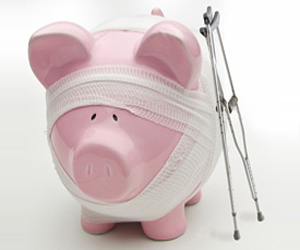Send this article to a friend:
March
04
2025
Send this article to a friend: March |
The Weirdest, Saddest Recession Indicator I Ever Heard Of
There’s a common lapse in memory that I see regularly among many people that like to get into the numbers in economics and finance (like me), and that is to forget the human side of the issue. Yes, the numbers are important because we have to know objectively what we’re looking at in order to make intelligent decisions instead of knee-jerk emotional mistakes. But the effects of economics and of bad economic policies is felt by everyday people, maybe especially those who don’t understand the numbers. Take a tragedy that I read about today that, if you think more deeply about it than the surface borderline cuteness of the topic, really speaks to what has been going on in our country. Kelly Tyko with Axios writes,
The Tooth Fairy? Really? Yes, really. But keep reading, because... The Tooth Fairy is important (and not just to kids) If you have kids, then you know that you would do almost anything for them, anything within your power. Especially when they’re little and still caught up in the magic of Santa Claus, the Easter Bunny, and, yes, the Tooth Fairy (not to mention still watching the claymation Rudolph the Red-Nosed Reindeer with you every Christmas to help you to indulge that secret pleasure from your childhood). Parents will work extra hours, buy the cheaper coffee, cut corners in other areas just so that they can get their kids that one brand of apple sauce that their child adores… … because it makes the little one happy. Listen, parents don’t reduce the amount that they give their kids from the Tooth Fairy unless they just don’t have the money. So, that begs the question… What’s going on? The short answer: we’re still dealing with the fallout of the last four years of terrible economic policies and the Keynesian policies that most administrations have pursued since the turn of the century… And the fallout is going to continue for a while longer. But if you’re like me, you probably want details, so, let’s get into those. For exhibit one, we have how the housing market is struggling. Mike Shedlock at MishTalk writes:
It’s not just multi-family units (duplexes and apartments), though. Back to Shedlock:
So, multi-family home building is worse than it was during the Great Recession, and new home sales are worse than when in the middle of dealing with the horrible inflation during the last administration. These are not good signs. Also, as you likely know, home sales, including multi-family units, is a key indicator of economic health and growth for the overall economy. If people aren’t buying new homes or if property developers aren’t building new apartment complexes, the only reasons are because either the builders can’t get the financing or because… People can’t afford to move to a bigger house or new apartment! In other words, people don’t have much money. Another disturbing statisticWhile some people will want to blame this next statistic on both Donald Trump and Elon Musk, if they’re being honest, they can’t. That doesn’t change the fact that it doesn’t signal good things. Mike Shedlock writes:
But before we start pointing fingers:
So, these figures are before the DOGE layoffs of federal workers. This is mostly (if not exclusively) private sector employees who are signing up for unemployment assistance. So far. Although a recent U.S. News article warned that as many as 300,000 federal workers and another 450,000 government contractors may lose their jobs in the months ahead. One analyst's grim perspective:
Not good. Not good at all. Incoming tariffs will push the cost of living higher Understand, I firmly believe that Trump’s policies will help the U.S. economy over the long term. In the short term, though, there’s going to be even more economic pain as Trump’s efforts kick in. Take tariffs, for example. The Wall Street Journal notes,
That’s $8,000-$12,000 per vehiclethat most of us don’t have! Most families are already cutting back on their Tooth Fairy budgets, for goodness’s sake. Most of the tariffs we’ve been promised have yet to materialize – so far. On Thursday, one Bloomberg story really captured the confusion nicely: 
And future tariffs are still far from certain – today, for example:
What’s going to happen next? No idea. And that very uncertainty undermines business confidence, possibly contributing to the rise in layoffs we discussed earlier. All this to say, our economic stress isn’t over, yet, folks. What you can doThere is something that you can do, though, to make sure that you and your family are on better footing (by far) than the average American. What is that? You can take a cue from that claymation Rudolph that we mentioned earlier by taking Yukon Cornelius’s advice: get silver and gold. Diversifing your savings with inflation-resistant investments can protect your purchasing power, regardless of the broader economic forces at work. Secure your savings so that you can weather whatever storm comes your way, and a good place to start your research into precious metals investing is right here.
|
Send this article to a friend:
 |
 |
 |